Creativity Particularities of Students Specializing in Humanities, Science, Technics in Kazakhstani Universities
Abstract
Future specialist’s creativity development is an important professional education task. On the one hand, a new generation of specialists will be capable of creating new technologies, products. On the other hand, creativity is an opportunity for a person self-expression. Are there any differences in the levels of students’ creativity specializing in science and humanities? Purpose of the Study: diagnostics of students’ creativity specializing in humanities and natural sciences, their comparison to develop further innovative techniques for enhancing creativity components of a person. Creation of maps as trajectories of students’ creativity diagnostics by step-by-step application tests. Research Methods: Synthesizing of diagnostic techniques into maps of trajectory of student creativity diagnostics using Tunnik’s test of student creativity levels, Mayers and Briggs test (MBTI). 60 students specializing in humanities and science took part in the research. The method of creating maps is offered as trajectories of diagnostic techniques for creativity assessment. According to Tunnik’s test high creativity level is diagnosed in 42,8% of students specializing in humanities and in 13% of respondents specializing in science and technology; average creativity level in 46,4% and 74% of respondents and low one in 11% and 13% of respondents respectively. The study has shown that according to MBTI test, psychological types characterized by organizational skills, communication skills, enthusiasm, inspiration, creative activities are widespread among representatives of humanities field. Psychological types characterized by administrative activity, logic, inspiration and delivery of information by means of language and examples are widespread among representatives of science and technology sphere
Keywords: University studentsdiagnostics of creativity
Introduction
Creativity is a great professional quality of the individual specialist of the XXI century. According
to N. Vishnyakova’s definition "creativity is a set of intellectual and personal skills of the individual,
contributing to self-nomination issues, generating a large number of original ideas and unconventional solutions" (Vishnjakova, 1998). We have already conducted a study on experimental study of
students’ creativity (Mynbayeva & others, 2016). This article presents new research results under the
grant from the Ministry of Education and Science of the Republic of Kazakhstan # 1763 / GF4
"Development of students' creativity as a factor of enhancing intellectual potential of Kazakhstan".
musical, logical-mathematical, spatial, bodily-kinesthetic, intrapersonal and interpersonal intelligences
(Gardner, 2011). By analogy, we asked the question, whether there is a difference between the
creativity of the humanities and natural sciences? The article presents theoretical data about the kinds
of creativity in research and we’ll make an empirical research.
sciences, their comparison to develop further innovative techniques for enhancing creativity
components of a person.
creativity diagnostics using Tunnik’s test of student creativity levels, N. Vishnjakova "Creativity" test,
Mayers and Briggs test (MBTI). 60 students from 5 universities of Kazakhstan specializing in
humanities and science took part in the research.
Types of creativity and art theory
A.V. Morozova believes that "creativity can be divided into
2000). Intellectual creativity involves cognition, which, in turn, consists of
intelligence.
the teacher creativity and the learning process, knowledge of modern concepts of creative training of
teachers. Management of student’s creativity at school has been studied in Kazakhstan (V. Shahgulari,
2010), the formation of the future specialists’ creativity (B. Ospanova, 2006), the pedagogical
conditions of development creative potential of students (Shvaykovsky A. 2009).
P. Ilyin systematized the following theory of creativity:
-
components of creativity were examined;
- insight in
-
person constantly constructs reality for himself putting forward a hypothesis;
-
weaknesses compensation for a man;
-
and not only the talent of gifted people. Creativity is present in every person, but internal and external
demand for their discovery is necessary. Intellectual and spiritual human activity is important for
creativity development;
- The nature creativity from the perspective of
C. Rogers defined the internal and external conditions of creative activity in humanistic psychology.
The internal conditions are: 1) extensionality (openness to new experience); 2) internal locus of
evaluation; 3) the ability to unusual combinations (Ilyin, 2009). External conditions for creativity are:
1) the psychological safety and security (the recognition of the absolute value of the individual,
creating an environment in which there is no external evaluation); 2) the psychological freedom of self
expression (Ilyin, 2009). Related components of creative act by C.Rogers is emotion (aesthetic,
heuristic, communicative, "disunion"). A. Maslow introduces the concept of primary and secondary
creativity. The primary creativity is understood as inspiration, an act of insight, the idea struck.
Secondary creativity is a hard work on the idea implementation, creation of a real artistic product
(Maslow, 2011).
Designing maps and diagnosis of university students’ creativity
As far as in different studies, we have tried about 20 diagnostic techniques of creativity, we had the
idea to articulate some of them in the diagnostic map. Visually one of the maps, called "Advanced
diagnostics of students’ creativity" is shown in Figure
includes 3 stages:
1) E.E. Tunick Test "Diagnostics of personal creativity";
2) "Creativity" test (author: N. Vishnjakova);
3) Myers-Briggs test on the person type (MBTI).
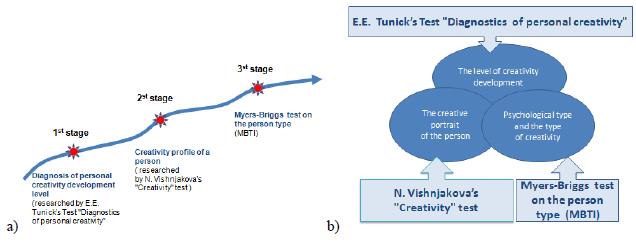
The reason for combining these techniques - the ability to get a complete picture of human creativity
and its relation to the psychological portrait. For the diagnosis maps the expected results are applied
(Figure
1) The level of creativity development;
2) The creative portrait of the person;
3) Psychological type and the type of creativity.
E.E. Tunick’s test is used in the first stage "Diagnosis of personal creativity." Using these
techniques we study the level of development of personal creativity and creative portrait of the
individual is drawn . E.E. Tunick’s test "Diagnostics of personal creativity" consists of 50 questions
and the time allowed to complete the test is 15 minutes (Tunick, 2002).
In the second stage the creative personality portrait is researched. Diagnosis is carried out using the
"Creativity" test, it allows to identify the level of creative inclinations of the individual and build a
psychological creative profile, reflecting creative component of the image of "I am real" and the idea of
the image of "I am perfect." Comparison of the two images of creativity "I am real" and "I am perfect"
allows you to define the creative reserve and creativity of the individual.
In the third stage the psychological type of the person and the type of creativity are studied.
Diagnosis is carried out using Myers-Brigg’s (MBTI) test of personality type . The test consists of 60
questions. The time allowed to complete the test is 20 minutes.
Results
All stages of creativity diagnostics were tested among the students of 60 respondents in the period
from April 2015 till November 2015 from 5 universities in Kazakhstan. The average age of
respondents was 22.5 years. The gender structure of respondents is represented by the following
percentages: 72% female respondents, 28% - male.
E.E. Tunick’s test allows to determine four characteristics of creative personality: curiosity (L);
imagination (B); complexity (C), risk inclination (P), and summing up the data on the presented
indicators, to identify the level of development of creativity of the individual (Tunick, 2002). The
results are shown in Figure
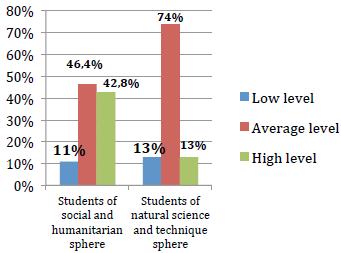
Analysis of the test results of students of 5 universities in Kazakhstan showed that out of 100% of
respondents among students of social and humanitarian areas high level of creativity was diagnosed in
42.8%. At the same time, a high level of creativity was detected in 13% of respondents specializing in
science and technology. Highly developed curiosity and imagination is characteristic for people with a
high level of creativity, knowledge of complex phenomena in this category is presented in a high
degree, and there is a high risk tolerance (Fetiskin N.P. & Kozlov V.V., 2002).
Qualities such as confidence in their abilities, self-esteem, high initiative, personal independence of
judgment and action, success and high social adaptability are characteristic to respondents with a high
level of creativity. An average (which is in the normal range) level of creativity is diagnosed in 46.4%
of the respondents from social and humanitarian areas and 74% of natural-science and technical
direction.
This suggests that respondents of this category have developed sufficiently creative personality
features, but low willingness to take risks, fear of making a mistake or get disapproval from others
prevent them to express themselves fully in their way. Timely provided psychological and educational
support to respondents with an average level of creativity within the walls of the university and extra
classes, the actual level of creativity can increase creativity to a high level.
11% of social and humanitarian areas and 13% of science and technology spheres respondents
showed a low level of creativity. These results suggest that psychological and special education is
needed, first of all, for such indicators as curiosity and risk appetite. Namely these indicators often low
developed in the study participants of this category (Tunick, 2002).
“Creativity” test allows us to identify the level of creative inclinations of the individual and build a
psychological creative profile by reflecting creative component of the image of “I am real” and the
idea of the image “I am perfect.” The results are shown in Figure
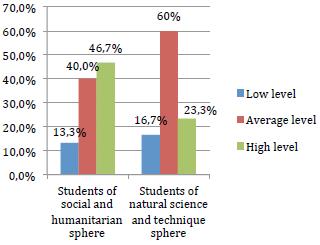
Analysis of the students’ test results from 5 universities in Kazakhstan showed that a high level of
creativity was diagnosed in 46.7% of the respondents from social and humanitarian areas. At the same time, a high level of creativity was detected in 23.3% of the respondents from science and technology
direction. This leads to the conclusion that the interviewed students have a high level of creativity,
open to new ideas, tend to solve their tasks in an original way.
The following qualities are characteristic to respondents with a high level of creativity:
- A high degree of thought fluency (number of ideas arising per unit of time);
- Highly developed abilities to develop hypotheses, irrelevance (the logical independence of the
reaction from stimulus);
- Predisposition to divergent thinking (alternative, multivariate thinking, assuming a lot of answers to
one question);
- High level of imagination, curiosity and originality of thought.
40% of respondents from social and humanitarian areas and 60% respondents from science and
technology directions showed an average (which is in the normal range) level of creativity. This
suggests that respondents in this category have developed enough qualities necessary for effective
display of their creative potential, but barriers (mental and behavioral stereotypes) prevent them to
express themselves fully.
Having overcome the identified barriers, above mentioned respondents can develop a high level of
creativity and demonstrate effectively the quality of their creative personality in various activities
(teaching, research, public, etc.).
13.3% students of social and humanitarian areas and 16.7% respondents of science and technology
directions showed low level of creativity.
A mismatch between the images "I am real" and "I am perfect" was revealed in 100% of the
respondents on all eight indicators of creativity
The largest gap is observed in four indicators: "Creative attitude to the profession", "Creative
thinking", "Originality" and "Imagination". This leads to the conclusion, that the above-mentioned
indicators of creativity respondents believe ideally underdeveloped and would like to improve them
significantly. At the same time, the majority participant students note that they see real opportunities to
develop their creative qualities in high schools, for example, in the framework of relevant disciplines,
creative workshops, master classes, psychological and pedagogical activities aimed at the development
of individual creative qualities and self-confidence.
The essence of MBTI psychological testing system is that thanks to measuring unique combination
of personal human factors, it is possible to predict his inclination to a certain type of activity, the style
of his action, the nature of solutions and other features that allow him to feel comfortable and confident
(Goldstein D. & Kroeger O., 2014).
MBTI personality test examines on 4 scales (descriptors):
1) Orientation of consciousness (introversion-extraversion);
2) Orientation in the situation (common sense - intuition);
3) The basis for decision-making (the Logos - the pathos);
4) A method of preparing decisions (rationality - irrationality).
Researchers David Goldstein, Otto Kroeger also emphasize 16 creative types (Figure
testing humanitarian specialties students are presented in Figure
Figure
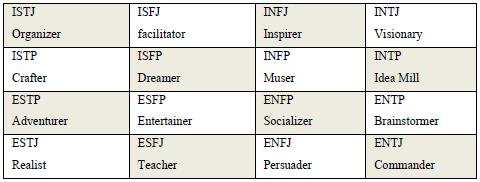
Analysis of test results showed that out of 16 possible creative types, respondents of
humanitarian and social direction diagnosed 10. ISTJ type is predominant type of creativity among the
respondents in the humanities, in psychological and pedagogical literature, often referred to as
"Organizer". This psychological and creative type was detected in 27.4% of participants. 21% of the
respondents relate to the ENFJ type or "Persuader". 13% are of ESFJ ("Teacher") type. In 13% we also
see the creative type INFJ ("Inspirer"). At 6.4% of the respondents are of ENFP ("Socializer") type,
4.8% are of ESTJ ("Realist") type. 6.4% relate to ENTJ type ("Commander"). 4.8% of the respondents
are of INTJ type ("Visionary"). Types ISFJ ("facilitator") and INFP ("Muser") were revealed at 1.6%
of each respondents.
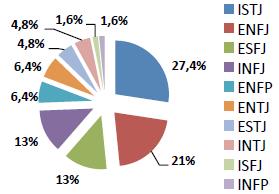
After having analyzed respondents data enrolled in the specialties of science and technology
spheres, we can conclude that the most common psychological types are ESTJ ("Realist") and ESFJ
("Teacher"). Two given types were met at 17.5% each. The second highest prevalence ENTJ
("Commander") types, the type INFJ ("Inspirer") and ENFJ type ("Persuader"). These three types were
detected in 12.5% of each respondents.
Types ISTJ ("Organizer"), INTJ ("Visionary"), ISFJ ("facilitator"), INFP ("Muser") were diagnosed
in 5% of each respondents.
Types ENTP ("Brainstormer "), ESFP ("Animator"), ISFP ("Dreamer") were revealed in 2.5% of
each respondents.
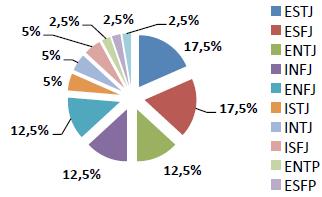
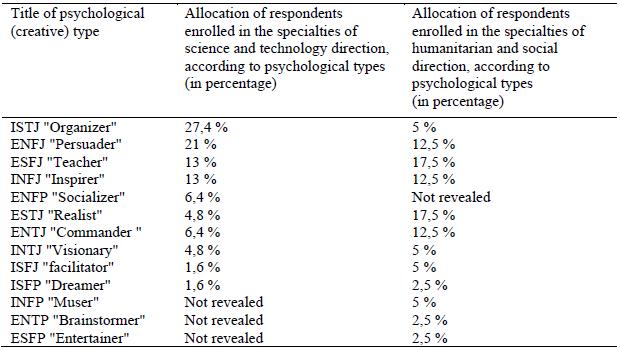
Thus, we can conclude that the representatives of the humanities and social professions are of more
common psychological types associated with organizational qualities, communication skills and
abilities, training and education of other people, enthusiasm, inspiration and creative activity.
The representatives of the science and technology areas are of more common psychological types
associated with the administrative activities, logic, education and training others, inspiration and
deliver information through language, examples (Goldstein D. & Kroeger O., 2014).
Let us turn to a brief description of psychological types according to the MBTI system. Start with
the most common types. ISTJ type ("Organizer"). This is introvert, sensing, logic, rational.
ENFJ type or "Persuader." ENFJ: extravert, intuit, ethics, rational. A very emotional person, prone
to empathy and expression of a wide range of emotions.
ESFJ type ("Teacher"). ESFJ: extrovert, sensing, ethics, rational and is able to influence people
with the help of emotional pressure, thus gets along well with them, can elevate mood, inclined to
sacrifice their own interests for the sake of another person and to love and care for loved ones
(Goldstein D. & Kroeger O., 2014).
INFJ type ("Inspirer"). INFJ: introvert, intuit, ethics, rational. Subtle sense of the nature relations
between people, attaches great importance to the trust, does not forgive betrayal. This person can
identify the hidden talents of others, endowed with educator talent.
ENFP type ("Socializer"). ENFP: extrovert, intuit, ethical, irrational and is able to be sensitive to
other people, possesses developed imagination. Loves creative work, can not stand the monotony and
routine, sociable, loves to give good advice interacting with people.
ESTJ type ("Realist"). ESTJ: extrovert, sensing, logical, rational, very hard-working, socially-
adapted type, always feels the need to bring the undertaking to complete. Plans activities, almost treat
others things (Goldstein D. & Kroeger O., 2014).
ENTJ type ("Commander"). ENTJ: extrovert, intuit, logic, rational and is able to clearly highlight
his own capabilities and the ability, easily inspired and start new businesses, interested in dynamic
sports, which give extreme sensations.
INTJ type ("Visionary"). INTJ: introvert, intuit, logical, rational and is able to distinguish the
important from the secondary, doesn’t not like idle talk, he is prone to clear practical thinking.
ISFJ Type ("facilitator"). ISFJ: introvert, sensing, ethical, rational). Recognizes artificiality and
hypocrisy in relationships, divides people into his own people and strangers, directing psychological
distance. ISFP: introvert, sensing, ethical, irrational). He is able to enjoy a normal life, quietly enduring
the monotony and routine. ENTP type ("Brainstormer"). ENTP: extrovert, intuit, logical, irrational). He
is distinguished from other people with a wide range of interests, is able to adapt to new conditions and
easily transfers to new working methods. ESFP ("Entertainer"). ESFP: extrovert, sensing, ethical,
irrational) and is able to see others possibilities, using this knowledge to manipulate (Goldstein D. &
Kroeger O., 2014).
Findings
1) While comparing creative portraits of humanities and social, technical and natural-science
specialty students it has been revealed, that the first often find themselves over emotional person, as
far as they have actual level of emotion and empathy should ideally ("I am ideal") to be much less, i.e.
unlike other creative qualities, not to grow in training and development, but rather decrease. Also
humanities students believe that emotions, especially negative, hinder the development of a creative
attitude to the profession. Indicator "emotionality, empathy" increases for students specialized in
techniques during training and personal development in higher education establishments (from course
to course), reaching the peak in the 4th year of study. For the representatives of the humanities and
social professions psychological types are more common associated with organizational qualities,
communication skills and abilities, training and education of other people, enthusiasm, inspiration and
creative activity. The representatives of the science and technology areas are more related to
psychological types associated with the administrative activities, logic, education and training others,
inspiration and deliver information through language, examples.
2) The obtained data allow us to conclude that the respondents of social and humanitarian specialties
compared to respondents of technical and natural science professions are dominated by creative
thinking and emotional components that are responsible for creative thinking and imagination,
emotional experience of research tasks, the production of new original ideas. Respondents of technical
and natural science professions in comparison with respondents of social and humanitarian specialties
are dominated by logical thinking and operational components that are responsible for the operation
and logical techniques. The development of one component of thinking compared to other explains the
differences between respondents of social and humanities and the respondents of technical and natural
science professions in manifestation of their creative abilities and views on the solution of research
problems, the approach to their solution, and provide the results.
3) Significant differences between respondents of social and humanitarian specialties and respondents
of technical and natural science disciplines have also been identified in relation to the nature of the
dominant type of imagination. The person with a predominance of visual, auditory or motor imagery
imagination most often can be met among the respondents of social and humanitarian specialties. Less
commonly, the person with a mixed type of imagination (i.e., those who have high development of
several types of imagination). The type of spatial imagination and technical mindset prevailed in
respondents of technical and natural science disciplines. Spatial imagination is necessary for students
and graduates in the study of solid geometry, it develops a careful viewing of drawings and natural
volume bodies in different ways. Spatial imagination and thinking, as a component in the solution of
practical problems associated with the place orientation and the things of nature is more necessary for
respondents of technical and natural science disciplines than creative thinking which prevail among
respondents of social and humanitarian fields.
4) In the process of psycho-pedagogical study of personality of the respondents it was revealed that
belonging to one or another type of imagination, significantly affects the individual psychological
characteristics of respondents. Accordingly, conditions for development of creative potential, creativity
and imagination should be created corresponding to their individual psychological characteristics of
the respondents of social humanities and technical and natural science disciplines
5) Correlation between the level of creativity and the willingness to risk level was revealed, which in
turn explains why a high level of creativity among respondents humanitarian and social direction is
diagnosed more often than representatives of the technical and natural science disciplines. Respondents
of technical and natural science disciplines are less prone to risky behavior, preferring to act according
to earlier worked out algorithm or not to risk at all, if you are not sure.
Conclusion
Maps as a diagnostic path except for use in the general study of the definition pattern of students’
creativity in higher educational institutions of Kazakhstan, can be used to diagnose students’ creativity
in the group for the design of future development and use of innovative techniques, as well as
individual research of student creativity. In the course of the study psychological and pedagogical
counseling was carried out with students to create a portrait of the individual student, including their
creative and psychological portrait, creative abilities of students. The next task is to design developing
training, based on the obtained results for students of humanities and natural science disciplines. The
purpose of training is the development of professional creativity and the overall creativity of students.
References
- Ilyin E.P. (2009). Psychology of creativity and talent. Sankt-Peterburg, Peter. Р.448 Fetiskin N.P. & Kozlov V.V. etc. (2002). Socio-psychological diagnosis of personality development
- and small groups. Moscow, Publishing House of the Institute of Psychotherapy. P. 490.
- Gardner, H. (2011). Frames of mind: The theory of multiple intelligences. Basic books.
- Goldstein D. & Kroeger O. (2014). Creative person. How to use the strengths of character for creativity development. Moscow, "Mann, Ivanov and Ferber".
- Vedenpää, Iida & Lonka, Kirsti (2014). Teachers’ and Teacher Students’Conceptions of Learning and Creativity. Creative Education, 5. P.1821-1833.
- Maslow, A. G. (2011). New frontiers of human nature / A.G. Maslow. Moscow, Smysl. P. 495.
- Morozov, A.V. (2001). Diagnosis of creativity: a monograph. Moscow, Academic Project. P. 224. Mynbayeva, A., Vishnevskaya, A. & Sadvakassova, Z. (2016). Experimental Study of Developing Creativity of University Students || Procedia - Social and Behavioral Sciences. 217. P.407 - 413.
- Ospanova, B.A. (2006). Pedagogical bases of creativity formation of future professionals in the university education system: Unpublished PhD Dissertation. Turkestan. P. 288.
- Shvaykovsky, A.S. (2009). Pedagogical conditions of development creative potential of students on the basis of innovative educational technologies. Unpublished PhD Dissertation. Shymkent. P.144. Shahgulari, V.V. (2010). Management of creative activity of pupils in the modern school. Almaty: Kazakh University. P.151.
- Sherbakova, E.E. (2000) Formation of pedagogical creativity of high school students in the conditions of vocational training. Unpublished PhD Thesis. Nizhny Novgorod. P. 10.
- Tunick, E.E. (2002). Psycho diagnostics of creative thinking. Creative tests. Sankt-Peterburg, Publishing house "Didactic Plus".
- Vishnjakova, N. (1995). Creative psycho pedagogy: Monograph. Part 1. Minsk. P.416.
Copyright information

This work is licensed under a Creative Commons Attribution-NonCommercial-NoDerivatives 4.0 International License.
About this article
Publication Date
14 May 2016
Article Doi
eBook ISBN
978-1-80296-007-5
Publisher
Future Academy
Volume
8
Print ISBN (optional)
-
Edition Number
1st Edition
Pages
1-252
Subjects
Psychology, social psychology, group psychology, collective psychology, teaching, teaching skills, teaching techniques
Cite this article as:
Mynbayeva, A., Vishnevskaya, A., & Akshalova, B. (2016). Creativity Particularities of Students Specializing in Humanities, Science, Technics in Kazakhstani Universities. In Z. Bekirogullari, M. Y. Minas, & R. X. Thambusamy (Eds.), Cognitive - Social, and Behavioural Sciences - icCSBs 2016, May, vol 8. European Proceedings of Social and Behavioural Sciences (pp. 143-153). Future Academy. https://doi.org/10.15405/epsbs.2016.05.15

